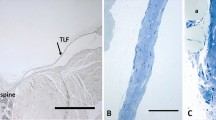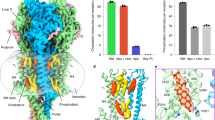Abstract
A HYPOTHESIS has suggested the existence of a cholinergic link in adrenergic transmission of postganglionic sympathetic nerve endings1. Much evidence has been presented in support of this hypothesis2,3. Botulinum toxin has been said to block sympathetic nerve transmission4. Botulinum toxin is known to block the release of acetylcholine from classically cholinergic nerve fibres5,6, and so it was suggested that sympathetic impairment by botulinum toxin reflects an action on the hypothetical cholinergic link in the sympathetic nerve fibre ending. Rather large concentrations of the toxin (20,000 to 50,000 L.D.50/ ml.) and long times (2–5 h) were, however, necessary to produce sympathetic blockage. It was therefore desirable to test the action of botulinum toxin on a dually innervated tissue so that effects on both classically adrenergic sympathetic fibres and classically cholinergic parasym-pathetic fibres could be observed in the same preparation.
This is a preview of subscription content, access via your institution
Access options
Subscribe to this journal
Receive 51 print issues and online access
$199.00 per year
only $3.90 per issue
Buy this article
- Purchase on Springer Link
- Instant access to full article PDF
Prices may be subject to local taxes which are calculated during checkout
Similar content being viewed by others
References
Burn, J. H., and Rand, M. J., Nature, 184, 163 (1959).
Burn, J. H., and Rand, M. J., Advances in Pharmacology, 1, 1 (1962).
Burn, J. H., and Rand, M. J., Ann. Rev. Pharmacol., 5, 163 (1965).
Rand, M. J., and Whaler, B. C., Nature, 206, 588 (1965).
Burgen, A. S. V., Dickens, F., and Zatman, L. J., J. Physiol., 109, 10 (1949).
Brooks, V. B., J. Physiol., 123, 501 (1954).
Vincenzi, F. F., and West, T. C., Brit. J. Pharmacol., 24, 773 (1965).
Amory, D. W., and West, T. C., J. Pharmacol., 137, 14 (1962).
Ambache, N., J. Physiol., 108, 127 (1949).
Ambache, N., Brit. J. Pharmacol., 6, 51 (1951).
Wright, G. P., Pharmacol. Rev., 7, 413 (1955).
Lewartowski, B., Nature, 199, 76 (1963).
Eccles, R. M., and Libet, B., J. Physiol., 157, 484 (1961).
MacIntosh, F. C., Canad. J. Biochem. Physiol., 37, 343 (1959).
Author information
Authors and Affiliations
Rights and permissions
About this article
Cite this article
VINCENZI, F. Effect of Botulinum Toxin on Autonomic Nerves in a Dually Innervated Tissue. Nature 213, 394–395 (1967). https://doi.org/10.1038/213394a0
Issue Date:
DOI: https://doi.org/10.1038/213394a0
This article is cited by
-
Nerves in cancer
Nature Reviews Cancer (2020)
-
Inhibition of synaptosomal choline uptake by tetanus and botulinum a toxin
Naunyn-Schmiedeberg's Archives of Pharmacology (1981)
-
Blockade by tetanus and botulinum A toxin of postganglionic cholinergic nerve endings in the myenteric plexus
Naunyn-Schmiedeberg's Archives of Pharmacology (1980)
-
Release of Noradrenaline from Sympathetic Endings
Nature (1971)
Comments
By submitting a comment you agree to abide by our Terms and Community Guidelines. If you find something abusive or that does not comply with our terms or guidelines please flag it as inappropriate.



